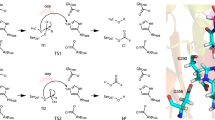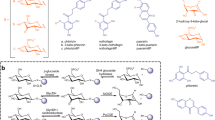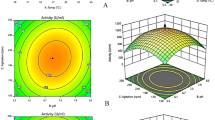Abstract
Two endo-β-1,4-glucanases, (EGI and EGII), produced by Schizophyllum commune display similar chemical and physical properties. In addition, their amino terminal amino acid sequences are identical except for an initial 16-residue alanine-rich sequence in EGI. We suggest that one explanation for the molecular heterogeneity of endoglucanases in this species is extracellular proteolytic cleavage of EGI. The catalytic sites of EGI and II have previously been proposed on the basis of structural similarities with lysozyme. Here, we infer a similar relationship between cellobiohydrolase I from Trichoderma reesei, and the proposed catalytic sites of EGI and II, from their respective amino acid sequences.
This is a preview of subscription content, access via your institution
Access options
Subscribe to this journal
Receive 12 print issues and online access
$259.00 per year
only $21.58 per issue
Buy this article
- Purchase on SpringerLink
- Instant access to full article PDF
Prices may be subject to local taxes which are calculated during checkout
Similar content being viewed by others
References
Brown, R.D., Jr., and Jurasek, L. (eds.). Hydrolysis of cellulose: Mechanisms of enzymatic and acid catalysis. 1979. Adv. Chem. Series 181. American Chem. Soc., Washington D.C.
Gritzali, M. and Brown, R.D., Jr. 1978. The cellulase system of Trichoderma . Adv. Chem. Series 181: 237–260.
Eriksson, K.E. and Pettersson, B. 1975. Extracellular enzyme system utilized by the fungus Sporotrichum pulverulentum for the breakdown of cellulose. 1. Separation, purification and physico-chemical characterization of five endo-1,4-β-glucanases. Eur. J. Biochem. 51: 193–206.
Eriksson, K.E. and Pettersson, B. 1975. Extracellular enzyme system utilized by the fungus Sporotrichum pulverulentum for the breakdown of cellulose. 3. Purification of physico-chemical characterization of an exo-1,4-β-glucanase. Eur. J. Biochem. 51: 213–218.
Nakayama, M., Tomita, Y., Suzuki, H. and Nisizawa, K. 1976. Partial proteolysis of some cellulase components from Trichoderma viride, and the substralc specificity of the modified products. J. Biochem. (Tokyo) 79: 955–966.
Gong, C.S., Ladisch, M.R. and Tsao, G.T. 1979. Biosynthesis, purification and mode of action of cellulases ofTrichoderma reesei . Adv. Chem. Series 181: 261–287.
Gum, E.K., Jr., and R.D., Brown, Jr. 1977. Comparison of four purified extracellular 1,4-β-D-glucan cellobiohydrolase enzymes from Trichoderma viride . Biochim. Biophys. Acta 492: 225–231.
Labudova, I., and Farkas, V. 1983. Multiple enzyme forms in the cellulase system of Trichoderma reesei during its growth on cellulose.Biochim. Biophys. Acta 744: 135–140.
Fagerstam, L.G. and Pettersson, L.G. 1980. The 1,4-β-glucan cello-biohydrolases of Trichoderma reesei QM9414. A new type of cellulolytic synergism. FEBS Letters. 119: 97–100.
Pettersson, L.G., Fagerstam, L.G., Bhikhabhai, R. and Leandoer, K. 1981. The cellulase complex of Trichoderma reesei QM9414. SPCI Intcrnatl. Symp. Wood and Pulping Chem. (Stockholm) Preprints. 3: 39–42.
Shoemaker, S., Watt, K., Tsitovsky, G. and Cox, R. 1983. Characterization and properties of cellulases purified from Trichoderma reesei strain L27. BIO/TECHNOLOGY 1: 687–690.
Shoemaker, S., Schweickart, V., Ladner, M., Gelfand, D., Kwok, S., Myambo, K. and Innis, M. 1983. Molecular cloning of exocellobiohydrolase I derived from Trichoderma reesei strain L27. BIO/TECHNOLOGY 1: 691–696.
Rho, D., Desrochers, M., Jurasek, L., Driguez, H. and Defaye, J. 1982. Induction of cellulase in Schizophyllum commune: Thiocellobiose as a new inducer. J. Bact. 149: 47–53.
Desrochers, M., Jurasek, L. and Paice, M.G. 1981. Production of cellulase β-glucosidase, and xylanase by Schizophyllum commune grown on a cellulose-peptone medium. Dev. Ind. Microbiol. 22: 675–684.
Desrochers, M., Jurasek, L. and Paice, M.G. 1981. High production of β-glucosidase in Schizophyllum commune: Isolation of the enzyme and effect of the culture filtrate on cellulose hydrolysis. Appl. Environ. Microbiol. 41: 222–228.
Shoemaker, S.P. and Brown, R.D. Jr. 1978. Enzymic activities of endo-1,4-(β-D-glucanases as purified from Trichoderma viride . Biochim. Biophys. Acta 523: 133–146.
Ng, T.K. and Zeikus, J.G. 1981. Purification and characterization of an endoglucanase (1,4-β-D-glucan glucanohydrolase) from Clostridium thermocellum . Biochem. J. 199: 341–350.
Izui, K., Nielsen, J.B.K., Caulfield, M.P. and Lampen, J.O. 1980. Large exopenicillinase initial extracellular form detected in cultures of Bacillus licheniformis . Biochemistry 19: 1882–1886.
Beguin, P., Cornet, P. and Millet, J. 1983. Identification of the endoglucanase encoded by the Cel B gene of Closlridium thennocdlum . Biochimie 65: 495–500.
Eriksson, K.E. and Pettersson, B. 1982. Purification and characterization of two acidic proteases from the white-rot fungus Sporotnchum pulverulentum . Eur. J. Biochem. 124: 635–642.
Yaguchi, M., Roy, C., Rollin, C.F., Paice, M.G. and Jurasek, L. 1983. A fungal cellulase shows sequence homology with the active site of hen egg-white lysozyme. Biechem. Biophys. Res. Comm. 116: 408–411.
Canfield, R.E. 1963. The amino acid sequence of egg-white lysozyme. J. Biol. Chem. 238: 2698–2707.
Schoentgen, F., Jollés, J. and Jollés, P. 1982. Complete amino acid sequence of ostrich (Struthio camelus) egg-white lysozyme, a goose-type lysozyme.Eur. J. Biochem. 123: 489–497.
Grütter, M.G., Weaver, L.H. and Matthews, B.W. 1983. Goose lysozyme structure: an evolutionary link between hen and bacteriophage lysozymes? Nature 303: 828–831.
Teeri, T., Salovuori, I. and Knowles, J. 1983. The molecular cloning of the major cellulase gene from Trichoderma reesei . BIO/TECHNOLOGY 1: 696–699.
Barker, W.C. and Dayhoff, M.O. 1972. Detecting distant relationships: computer methods and results, p.101–110. In Atlas of protein sequence and structure. M. O. Dayhoff (ed.), National Biomed. Res. Foundation Maryland.
Doolittle, R.F. 1981. Similar amino acid sequences: Chance or common ancestry? Science 214: 149–158.
Inoye, M., Imada, M., and Tsugita, A. 1970. The amino acid sequence of T4 phage lysozyme. 4. Dilute acid hydrolysis and the order of tryptic peptides. J. Biol. Chem. 245: 3479–3484.
Matthews, B.W., Grütter, M.G., Anderson, W.F. and Remington, S.J. 1981. Common precursor of lysozymes of hen egg-white and bacteriophage T4. Nature 290: 334–335.
Barras, D.R, Moore, A.E., and Stone, B.A. 1969. Enzyme substrate relationships among β-glucan hydrolases. Adv. Chem. Ser. 95: 105–138.
Paice, M.G. and Jurasek, L. 1979. Structural and mechanistic comparisons of some β1,4-glycoside hydrolases. Adv. Chem. Series 181: 361–374.
Paice, M.G. and Jurasek, L. 1984. Removing hemicellulose from pulps by specific enzymic hydrolysis. J. Wood Chem. Tech. in press.
Hulme, M.A. 1971. Viscometric determination of carboxymethyl-cellulase in standard international units. Arch. Biochem. Biophys. 147: 49–54.
Weber, K. and Osborn, M. 1975. Proteins and sodium dodecyl sulfate:molecular weight determinations on polyacrylamide gels and relative procedure,p.179–233. In The Proteins Vol.1. H. Neurath R. L. Hill, and C. Boeder (eds.), Academic Press Inc., New York.
Miller, G.L. 1963. Hydrolysis of cellulose to oligosaccharides. Methods Carbohydr. Chem. 3: 134–138.
Gum, E.K. Jr. and Brown, R.D. Jr. 1977. Two alternative hplc separation methods for reduced and normal cellooligosaccharides. Anal. Biochem. 82: 372–375.
Liu, T.-Y. and Chang, Y.H. 1971. Hydrolysis of proteins with p-tolucnesulfonic acid. J. Biol. Chem. 248: 2842–2848.
Lottspeich, F., Geiger, R., Henschen, A. and Kutzbach, C. 1979. N-terminal amino acid sequence of human urinary kallikrein. Homology with other serine proteases. Hoppe-Seyler's Z. Physiol. Chem. 360: 1947–1950.
Mendez, E. and Lai, S.Y. 1975. Regeneration of amino acids from thiazolinones formed in the Edman degradation. Anal. Biochem. 68: 47–53.
Author information
Authors and Affiliations
Rights and permissions
About this article
Cite this article
Paice, M., Desrochers, M., Rho, D. et al. Two Forms of Endoglucanase from the Basidiomycete Schizophyllum Commune and their Relationship to Other β-1,4-Glycoside Hydrolases. Nat Biotechnol 2, 535–539 (1984). https://doi.org/10.1038/nbt0684-535
Received:
Accepted:
Issue date:
DOI: https://doi.org/10.1038/nbt0684-535
This article is cited by
-
Biodegradation of bio-sourced and synthetic organic electronic materials towards green organic electronics
Nature Communications (2021)



